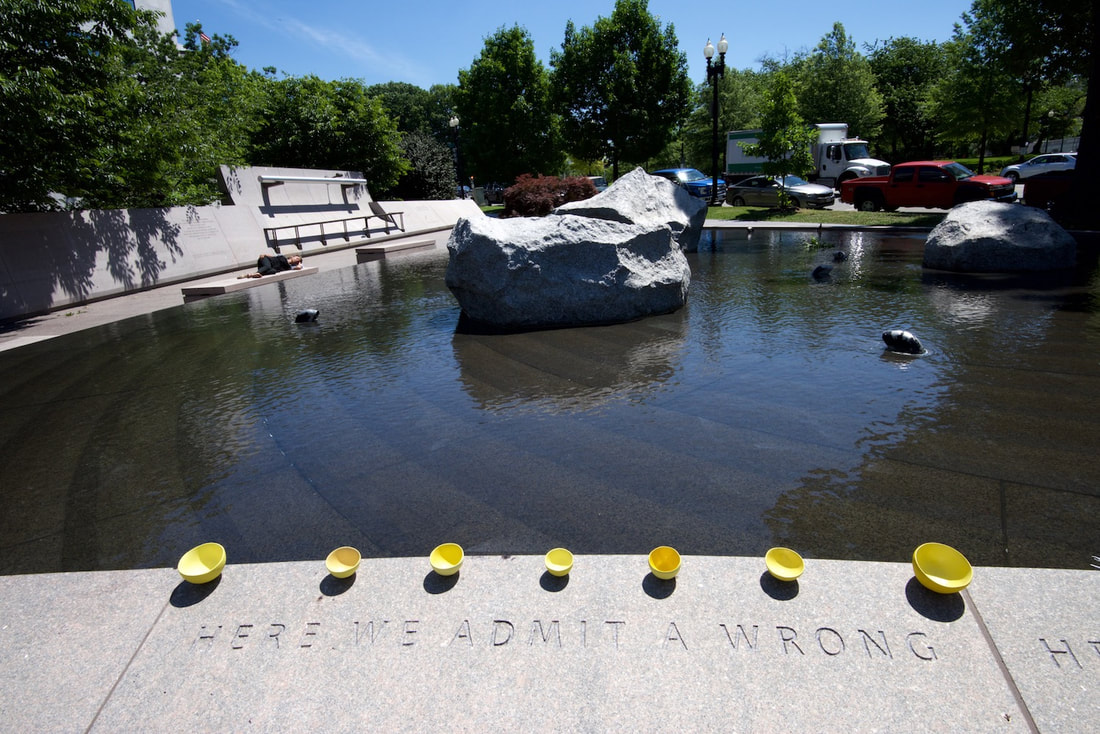|
The last time the tea bowls visited the nation’s capital was in June of 2016. They visited two places. First, they got to hang out at the steps of the Supreme Court for a bit. While I was setting up, many curious passersby asked what I was doing with all these yellow bowls. As there were many lawyers in the area, some actually remembered hearing about one of the four cases I was showcasing: Fred Korematsu v. United States, Gordon Hirabayashi v. United States, Yasui v. United States and Ex parte Endo. However, the majority of them, tourists, had no idea. The funniest reaction I received was from a young black man and his mother who lived locally, in Washington, DC. They were watching me set up for a while and finally had the courage to interrupt and ask what I was doing. When I told them the story of the forced removal and mass incarceration of Japanese Americans during WWII, the young man turned to his mother and said, “Did you know this?” His mother shook her head and said quietly, no. Then he turned to me and said, “That happened in America??? No sh--!!!” We all broke out laughing. Here’s a link to an earlier blog if you want to know more about that image. After taking that image and repacking everything, we moved over to the second spot...The Memorial to Japanese-American Patriotism which is part of the National Parks Service. It’s just a five-minute walk from Union Station. The small park with the beautiful water feature shown at the top tells the story of American men, women and children of Japanese ethnicity and their immigrant parents who were imprisoned in ten US concentration camps in the deserts and swamps of the American west and Midwest. Carved into the stone next to the pool are the words “Here We Admit a Wrong.” It was so peaceful and quiet, with very few visitors, that in an appropriately ironic twist, it had become a popular napping spot for homeless people (as you can see in the top image if you look carefully). Ten panels line the wall of the Memorial adjacent to the pool, each with the names of the camps and the number of individuals who were imprisoned. At the center is the sculpture of a bird, a crane, entangled in barbed wire. It’s also a memorial to the Japanese-American men and women, many of whom were recruited from these American camps, who went to fight for the four freedoms abroad, but also to win freedom for those family members who remained imprisoned at home.
The 442nd and 100th Battalion, a segregated Japanese-American military fighting unit, would become the most decorated unit of its size and duration in US military history. The unit was awarded: 9486 Purple Hearts 4000 Bronze Stars 560 Silver Stars 29 Distinguished Service Crosses 21 Medals of Honor 7 Presidential Unit Citations 800 were killed/or missing in action. 6,000 would serve in the Military Intelligence Service as translators and interpreters, and others would serve in the nurses’ corps. In the end, its said that about 33,000 would go on to serve in the US armed forces during WWII. Now, to today. As of this month, the Yellow Bowls, represented by one of the images from the Freedom from Fear/Yellow Bowl Project, can be found at the George Washington University/Textile Museum, part of an exhibition called “Enduring Ideals: Rockwell, Roosevelt and the Four Freedoms,” which opened in Washington, DC, on February 13, 2019. Here’s a link to an article in the Berkshire Eagle announcing the opening of Norman Rockwell’s Four Freedom’s paintings depicting FDR’s 1941 Four Freedoms speech. Essentially, the exhibition is split into two. The main floor depicts much of the commercial and propaganda art that the illustrator Norman Rockwell produced for magazines and the government leading up to and during WWII. In 1943, Norman Rockwell was paid to illustrate FDR’s Four Freedoms for the Saturday Evening Post. His depictions met with little fanfare at first. But they would eventually become iconic after the Post and the US Department of the Treasury teamed up to sponsor a two-year touring exhibition of the paintings, exhibiting them around the nation, as a way to promote American patriotism and the sale of war bonds. On the second level of the museum is a non-commercial contemporary take on those Freedoms. The gallery here is filled with art that questions how universal those freedoms were and are today—but from the perspective of those who were denied those freedoms. They include images from Norman Rockwell, himself, who had advocated for Black Civil Rights and the “Right to Know” during the Vietnam War. My contribution to the story of the Four Freedoms should be in this section...Let me know if you find it!
2 Comments
Donad E. Collins
2/27/2019 04:38:56 pm
Nice essay. The sculpture at the monuments is fascination. The remark of the little boy made me laugh. The list of unit awards make an impression on those unaware of the unit's history. These should be published more often. They make an impression on me, and I already know the story. Congratulations on the display.
Reply
Leave a Reply. |
Setsuko WinchesterMy Yellow Bowl Project hopes to spur discussion around these questions: Who is an American? What does citizenship mean? How long do you have to be in the US to be considered a bonafide member of this group? Archives
June 2021
Categories |


 RSS Feed
RSS Feed